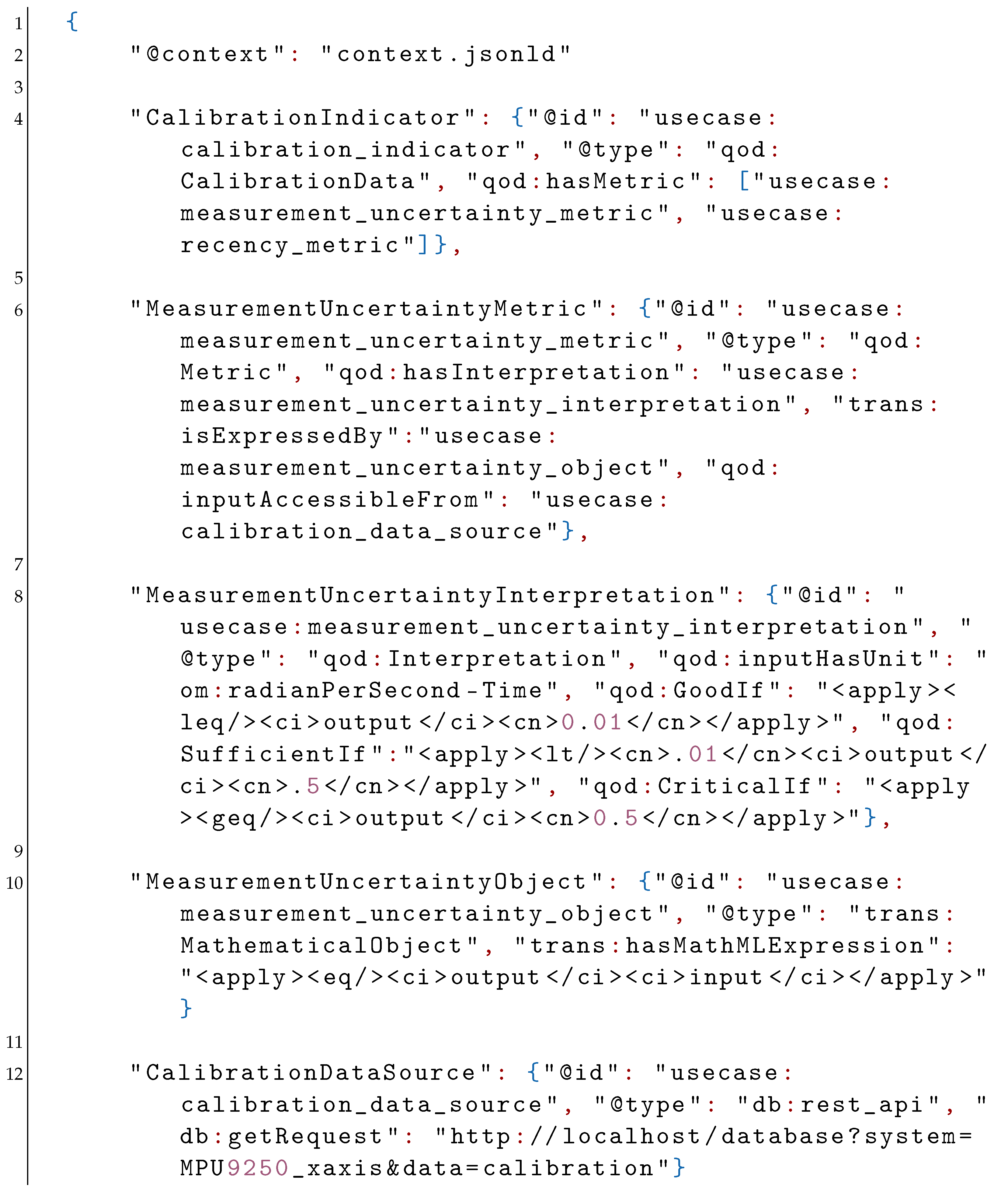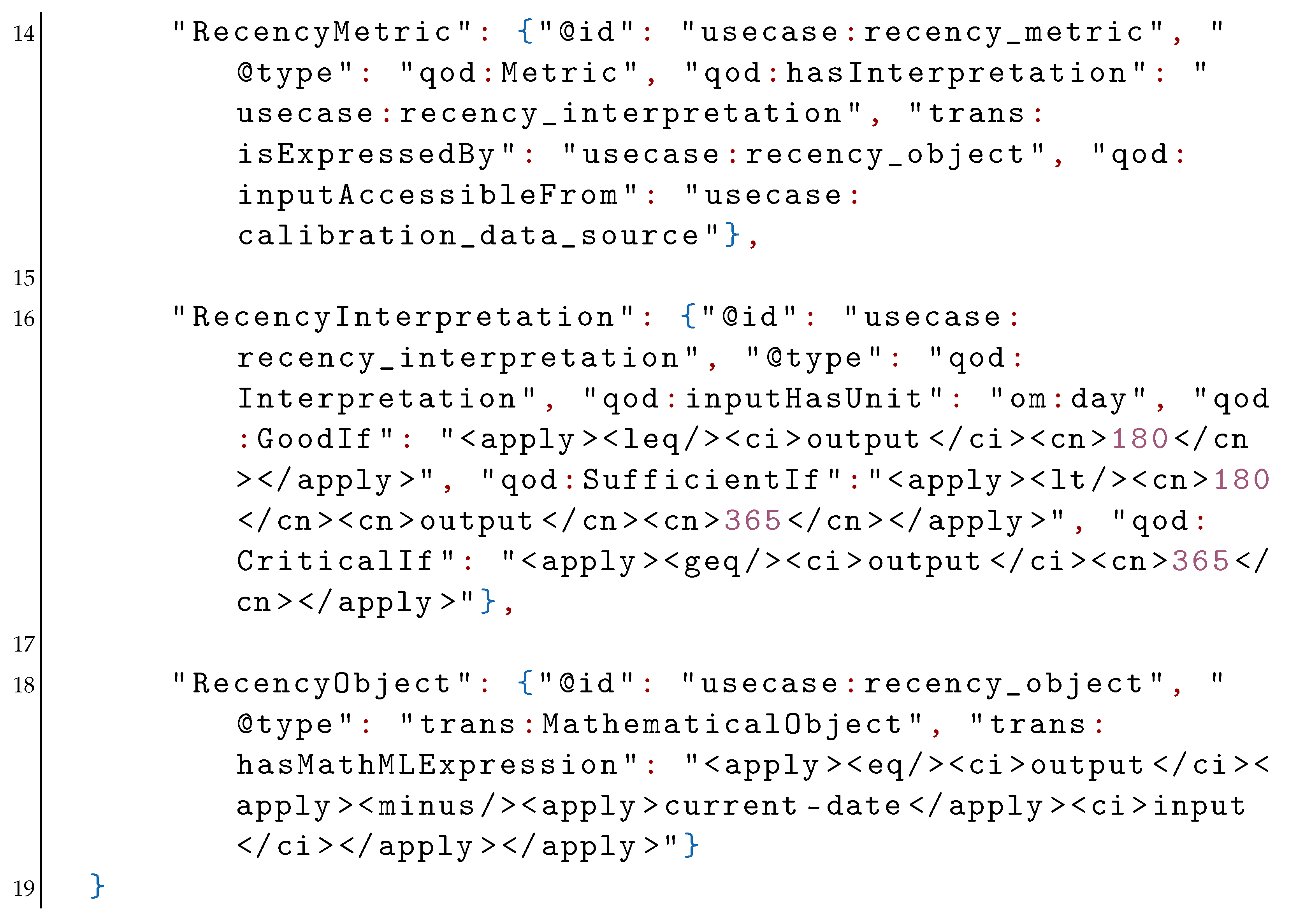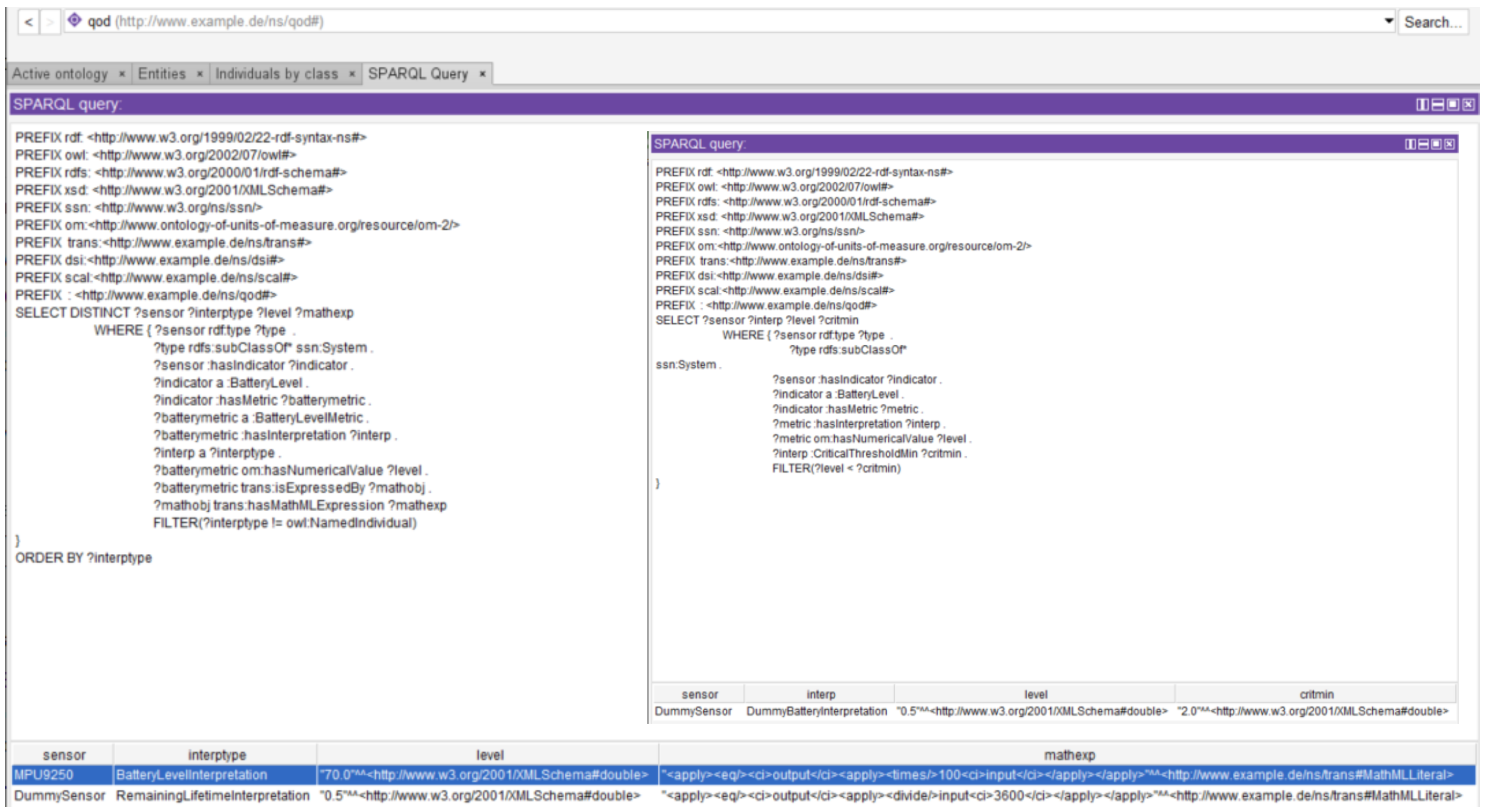Semantic Description of Quality of Data in Sensor Networks
Abstract
1. Introduction
2. Semantic Description of QoD in Sensor Networks
- an abstract measuring “System”;
- a QoD indicator corresponding to a particular sensor or data property;
- a metric describing an assessment procedure for the indicator;
- an interpretation of the metric.
2.1. QoD Indicators
- Accuracy: The degree of “closeness” of the data with respect to the correct measurement of the physical phenomenon being observed. The accuracy of a new sensor in a network can be assessed by comparing it, for example, with a reference sensor or with an aggregate value from multiple sensors observing the same physical quantity.
- Completeness: A measure of the number of missing or null values. A high percentage of missing values from a sensor could stem from hardware or network issues and is bound to influence the usability of the data.
- Timeliness: A quality dimension expressing the currency or recentness of the data. Certain users or time-critical applications can use this indicator to assess the time delay between the measurement and the acquisition of data.
- Consistency: The degree to which data adheres to pre-defined criteria. For sensor data, the operating range is a common criterion. Another example would be to check for the consistency of the data according to its measurement principle, e.g., negative masses not allowed; cf. Figure 1.
- Battery level: The sensor battery level can be represented either as a percentage or as the remaining lifetime given the current rate of power consumption. As sensors tend to provide unstable readings towards the end of their battery lifetime [25], a low battery level also serves as a predictor for other QoD issues.
- Calibration data: Information such as the results of a calibration in the form of a measurement uncertainty as well as administrative metadata such as the place and date of calibration and the qualification of the person carrying out the calibration are included in a digital calibration certificate (DCC) [6].
- Operating conditions: Any description of a sensor’s behavior must normally include the specification of its operating conditions. Sensor calibrations, for instance, are performed under the specific temperature and humidity conditions experienced during sensor operation.
- Sampling rate: A sensor’s actual sampling rate can differ greatly from the value specified on its data sheet. For instance, a smart sensor may lower its own sampling rate in order to reduce power consumption.
2.2. QoD Metrics
- Measurement uncertainty: The uncertainty on a calibration certificate can be directly incorporated into a quality description for a sensor. The “score” attributed would be the numerical value of the uncertainty along with the physical units.
- Recency: The “age” of the calibration or when the sensor was last calibrated. Given the natural wear of components, sensors which have been recently calibrated are by and large more trustworthy. The metric in this case would be the difference between the current timestamp and the timestamp corresponding to the calibration date.
2.3. QoD Interpretation
- the sufficiency of the battery level with respect to certain requirements;
- the presence of drift beyond a certain threshold in sensor measurements;
- the calibration not being sufficiently up-to-date;
- the sensor operating in unsuitable environmental conditions.
3. Ontologies in Sensor Networks
- 1.
- the Digital SI (D-SI, [35]) data model to represent the observation values, units and uncertainties,
- 2.
- 3.
- the Geographic Query Language (GeoSPARQL, [38]) for the geometric and topological location information.
3.1. The qod Ontology
3.1.1. Ontology Structure
- the ssn:System class imported from the SSN ontology representing the sensing system under investigation,
- the Indicator class that represents the abstract QoD indicator in question,
- the Metric class corresponding to the method used to calculate the QoD score with respect to a particular indicator and,
- the Interpretation class that describes the interpretation associated with a particular metric.
4. Evaluation
4.1. JSON-LD Representation
- Unordered collections of comma-separated name/value pairs called objects enclosed in braces . Each name is necessarily a string which is followed by a colon and the value assigned to the name as “name”: value.
- Ordered lists of comma-separated values which are contained within square brackets . Allowed values are strings specified in double quotes, numbers, booleans, null, or objects and arrays themselves. Objects and arrays can thus be nested.




4.2. Competency Questions
- Which sensors have a critical battery value?
- Which Metric was used to calculate the battery value?
- Which of two given sensors has a lower measurement uncertainty?
- Which sensors have not been calibrated recently?
- Which types of Indicator are available for a given system
- Which types of Metric are available for a given Indicator?
- What is the MathematicalObject corresponding to the TimelinessMetric?
5. Conclusions
Author Contributions
Funding
Institutional Review Board Statement
Informed Consent Statement
Data Availability Statement
Acknowledgments
Conflicts of Interest
Abbreviations
| SSN | Semantic Sensor Network |
| SOSA | Sensor, Observation, Sample, Actuator |
| QoD | Quality of data |
| QoS | Quality of Sensing |
| IoT | Internet of Things |
| IIoT | Industrial Internet of Things |
| DCC | Digital Calibration Certificate |
| CQ | Competency Question |
| SI | Système international (d’unités) |
| VIM | Vocabulaire International de Métrologie |
| D-SI | Digital SI |
| IRI | Internationalized Resource Identifier |
References
- Boyes, H.; Hallaq, B.; Cunningham, J.; Watson, T. The industrial internet of things (IIoT): An analysis framework. Comput. Ind. 2018, 101, 1–12. [Google Scholar] [CrossRef]
- Hermann, M.; Pentek, T.; Otto, B. Design Principles for Industrie 4.0 Scenarios. In Proceedings of the 2016 49th Hawaii International Conference on System Sciences (HICSS), Koloa, HI, USA, 5–8 January 2016; pp. 3928–3937. [Google Scholar] [CrossRef]
- Joint Committee for Guides in Metrology. JCGM 100: Evaluation of Measurement Data-Guide to the Expression of Uncertainty in Measurement. 2008. Available online: https://www.bipm.org/documents/20126/2071204/JCGM_100_2008_E.pdf (accessed on 27 September 2021).
- Eichstädt, S. Publishable Summary for 17IND12 Met4FoF “Metrology for the Factory of the Future”. 2020. Available online: https://zenodo.org/record/3404800 (accessed on 27 September 2021).
- BIPM; IEC; IFCC; ILAC; ISO; IUPAC; IUPAP; OIML. International Vocabulary of Metrology-Basic and General Concepts and Associated Terms (VIM); JCGM: Sèvres, France, 2012; Available online: https://www.bipm.org/documents/20126/2071204/JCGM_200_2012.pdf (accessed on 27 September 2021).
- Hackel, S.; Härtig, F.; Hornig, J.; Wiedenhöfer, T. The digital calibration certificate. PTB-Mitteilungen Forsch. Prufen 2017, 127, 75–81. [Google Scholar]
- Li, Y.; Parker, L.E. Nearest Neighbor Imputation Using Spatial-Temporal Correlations in Wireless Sensor Networks. Inf. Fusion 2014, 15, 64–79. [Google Scholar] [CrossRef] [PubMed]
- Eichstädt, S.; Gruber, M.; Vedurmudi, A.P.; Seeger, B.; Bruns, T.; Kok, G. Toward Smart Traceability for Digital Sensors and the Industrial Internet of Things. Sensors 2021, 21, 2019. [Google Scholar] [CrossRef]
- Goebel, K.; Yan, W. Correcting Sensor Drift and Intermittency Faults with Data Fusion and Automated Learning. IEEE Syst. J. 2008, 2, 189–197. [Google Scholar] [CrossRef]
- Cannarile, F.; Baraldi, P.; Colombo, P.; Zio, E. A Novel Method for Sensor Data Validation based on the analysis of Wavelet Transform Scalograms. Int. J. Progn. Health Manag. 2018, 9. [Google Scholar] [CrossRef]
- Teh, H.Y.; Kempa-Liehr, A.W.; Wang, K.I.K. Sensor data quality: A systematic review. J. Big Data 2020, 7, 11. [Google Scholar] [CrossRef]
- Schütze, A.; Helwig, N. Sensorik und Messtechnik für die Industrie 4.0. tm-Tech. Mess. 2017, 84, 310–319. [Google Scholar] [CrossRef][Green Version]
- Schneider, T.; Helwig, N.; Schuetze, A. Industrial condition monitoring with smart sensors using automated feature extraction and selection. Meas. Sci. Technol. 2018, 29, 094002. [Google Scholar] [CrossRef]
- Eichstädt, S.; Ludwig, B. Metrology for heterogeneous sensor networks and Industry 4.0. at-Automatisierungstechnik 2020, 68, 459–464. [Google Scholar] [CrossRef]
- D’Aniello, G.; Gaeta, M.; Hong, T. Effective Quality-Aware Sensor Data Management. IEEE Trans. Emerg. Top. Comput. Intell. 2018, 2, 65–77. [Google Scholar] [CrossRef]
- Berners-Lee, T.; Hendler, J.; Lassila, O. The Semantic Web. Sci. Am. 2001, 284, 34–43. [Google Scholar] [CrossRef]
- Sheth, A.; Perry, M. Traveling the Semantic Web through Space, Time, and Theme. IEEE Internet Comput. 2008, 12, 81–86. [Google Scholar] [CrossRef]
- Padmavathi, T.; Krishnamurthy, M. Semantic Web Tools and Techniques for Knowledge Organization: An Overview. Knowl. Organ. 2017, 44, 273–290. [Google Scholar] [CrossRef]
- Bertossi, L.; Rizzolo, F.; Jiang, L. Data Quality Is Context Dependent. In Enabling Real-Time Business Intelligence; Castellanos, M., Dayal, U., Markl, V., Eds.; Springer: Berlin/Heidelberg, Germany, 2011; pp. 52–67. [Google Scholar]
- Kuka, C.; Nicklas, D. Enriching sensor data processing with quality semantics. In Proceedings of the 2014 IEEE International Conference on Pervasive Computing and Communication Workshops (PERCOM WORKSHOPS), Budapest, Hungary, 24–28 March 2014; pp. 437–442. [Google Scholar] [CrossRef]
- Fortuna, L.; Graziani, S.; Rizzo, A.; Xibilia, M. Soft Sensors for Monitoring and Control of Industrial Processes; Springer: London, UK, 2007. [Google Scholar] [CrossRef]
- Shang, C.; Yang, F.; Huang, D.; Lyu, W. Data-driven soft sensor development based on deep learning technique. J. Process. Control 2014, 24, 223–233. [Google Scholar] [CrossRef]
- Klein, A.; Lehner, W. Representing Data Quality in Sensor Data Streaming Environments. J. Data Inf. Qual. 2009, 1, 1–28. [Google Scholar] [CrossRef]
- Sachidananda, V.; Khelil, A.; Suri, N. Quality of information in wireless sensor networks. In Proceedings of the 15th International Conference on Information Quality, ICIQ 2010, Little Rock, AR, USA, 12–14 November 2010. MIT Information Quality Program. [Google Scholar]
- Ye, J.; Stevenson, G.; Dobson, S. Detecting abnormal events on binary sensors in smart home environments. Pervasive Mob. Comput. 2016, 33, 32–49. [Google Scholar] [CrossRef]
- Geisler, S.; Weber, S.; Quix, C. Ontology-based data quality framework for data stream applications. In Proceedings of the 16th international conference on information quality (ICIQ-11), Paris, France, 18–20 November 2011; Koronios, A., Gao, J., Eds.; pp. 145–159. [Google Scholar]
- Gruber, T.R. A Translation Approach to Portable Ontology Specifications. Knowl. Acquis. 1993, 5, 199–220. [Google Scholar] [CrossRef]
- Patel-Schneider, P.; Parsia, B.; Motik, B. OWL 2 Web Ontology Language. Structural Specification and Functional-Style Syntax, 2nd ed.; World Wide Web Consortium (W3C); Online; 2012; Available online: https://www.w3.org/TR/owl2-syntax/ (accessed on 27 September 2021).
- Sheth, A.; Henson, C.; Sahoo, S. Semantic Sensor Web. Internet Comput. IEEE 2008, 12, 78–83. [Google Scholar] [CrossRef]
- Gruber, M.; Eichstädt, S.; Neumann, J.; Paschke, A. Semantic information in sensor networks: How to combine existing ontologies, vocabularies and data schemes to fit a metrology use case. In Proceedings of the 2020 IEEE International Workshop on Metrology for Industry 4.0 & IoT, Roma, Italy, 3–5 June 2020; pp. 469–473. [Google Scholar]
- Vedurmudi, A.P.; Gruber, M.; Eichstädt, S.; Paschke, A. Semantics in Sensor Networks: An Ontology for Dynamic Transfer Behavior in Calibrated Sensors. In Proceedings of the IEEE 2021 International Workshop on Metrology for Industry 4.0 & IoT, Rome, Italy, 7–9 June 2021; pp. 358–363. [Google Scholar]
- Lefort, L.; Henson, C.; Taylor, K.; Compton, M.; Corcho, Ó.; Castro, R.; Graybeal, J.; Herzog, A.; Janowicz, K.; Neuhaus, H.; et al. Semantic Sensor Network XG Final Report. 2011. Available online: https://www.w3.org/2005/Incubator/ssn/XGR-ssn-20110628/ (accessed on 27 September 2021).
- Haller, A.; Janowicz, K.; Cox, S.; Lefrançois, M.; Taylor, K.; Le-Phuoc, D.; Lieberman, J.; García-Castro, R.; Atkinson, R.; Stadler, C. The modular SSN ontology: A joint W3C and OGC standard specifying the semantics of sensors, observations, sampling, and actuation. Semant. Web 2019, 10, 9–32. [Google Scholar] [CrossRef]
- Janowicz, K.; Haller, A.; Cox, S.J.; Le Phuoc, D.; Lefrançois, M. SOSA: A lightweight ontology for sensors, observations, samples, and actuators. J. Web Semant. 2019, 56, 1–10. [Google Scholar] [CrossRef]
- Hutzschenreuter, D.; Härtig, F.; Heeren, W.; Wiedenhöfer, T.; Forbes, A.; Brown, C.; Smith, I.; Rhodes, S.; Linkeová, I.; Sýkora, J.; et al. SmartCom Digital System of Units (D-SI) Guide for the Use of the Metadata-Format Used in Metrology for the Easy-To-Use, Safe, Harmonised and Unambiguous Digital Transfer of Metrological Data. 2019. Available online: https://zenodo.org/record/3522631#.YUv6sGJByUk (accessed on 27 September 2021).
- Rijgersberg, H.; van Assem, M.; Top, J. Ontology of units of measure and related concepts. Semant. Web 2013, 4, 3–13. [Google Scholar] [CrossRef]
- Gruber, T.R.; Olsen, G.R. An Ontology for Engineering Mathematics. In Proceedings of the Fourth International Conference on Principles of Knowledge Representation and Reasoning, Bonn, Germany, 24–27 May 1994; pp. 258–269. [Google Scholar]
- Battle, R.; Kolas, D. Enabling the geospatial Semantic Web with Parliament and GeoSPARQL. Semant. Web 2012, 3, 355–370. [Google Scholar] [CrossRef]
- Ausbrooks, R.; Buswell, S.; Carlisle, D.; Chavchanidze, G.; Dalmas, S.; Devitt, S.; Diaz, A.; Dooley, S.; Hunter, R.; Ion, P.; et al. Mathematical Markup Language (MathML) Version 3.0. 2014. Available online: https://www./TR/2014/REC-MathML3-20140410/ (accessed on 21 June 2021).
- Nevzorova, O.A.; Zhiltsov, N.; Kirillovich, A.; Lipachev, E. OntoMathPROOntology: A Linked Data Hub for Mathematics. In International Conference on Knowledge Engineering and the Semantic Web; Klinov, P., Mouromtsev, D., Eds.; Springer: Berlin/Heidelberg, Germany, 2014; pp. 105–119. [Google Scholar]
- Baillie, C.; Edwards, P.; Pignotti, E.; Corsar, D. Short paper: Assessing the quality of semantic sensor data. In Proceedings of the 6th International Workshop on Semantic Sensor Networks, Sydney, Australia, 22 October 2013. [Google Scholar]
- Belhajjame, K.; Cheney, J.; Corsar, D.; Garijo, D.; Soiland-Reyes, S.; Zednik, S.; Zhao, J. PROV-O: The PROV Ontology. 2012. Available online: https://www.w3.org/TR/prov-o/ (accessed on 27 September 2021).
- Taylor, K.; Haller, A.; Lefrançois, M.; Cox, S.; Janowicz, K.; García-Castro, R.; Le-Phuoc, D.; Lieberman, J.; Atkinson, R.; Stadler, C. The Semantic Sensor Network Ontology, Revamped. In Proceedings of the Journal Track Co-Located with the 18th International Semantic Web Conference (ISWC 2019), Auckland, New Zealand, 26 October 2019. [Google Scholar]
- Musen, M. The protégé project: A look back and a look forward. AI Matters 2015, 14, 4–12. [Google Scholar] [CrossRef]
- Noy, N.F.; Musen, M.A. PROMPT: Algorithm and Tool for Automated Ontology Merging and Alignment. In Proceedings of the Seventeenth National Conference on Artificial Intelligence (AAAI-2000), Austin, TX, USA, 30 July–3 August 2000. [Google Scholar]
- TDK Corporation, San Jose, CA. TDK-InvenSense Motion Sensor Universal Evaluation Board (UEVB) User Guide. 2017. Available online: https://invensense.tdk.com/download-pdf/invensense-motion-sensor-universal-evaluation-board-uevb-user-guide/ (accessed on 23 June 2021).
- Sporny, M.; Longley, D.; Kellogg, G.; Lanthaler, M.; Lindström, N. JSON-LD 1.1: A JSON-Based Serialization for Linked Data. 2019. Available online: https://json-ld.org/spec/latest/json-ld/ (accessed on 29 June 2021).
- Pezoa, F.; Reutter, J.L.; Suarez, F.; Ugarte, M.; Vrgoč, D. Foundations of JSON schema. In Proceedings of the 25th International Conference on World Wide Web; International World Wide Web Conferences Steering Committee: Montréal, QC, Canada, 2016; pp. 263–273. [Google Scholar]
- Bizer, C.; Heath, T.; Berners-Lee, T. Linked Data: The Story so Far. Int. J. Semant. Web Inf. Syst. 2009, 5, 1–22. [Google Scholar] [CrossRef]
- Dürst, M.J.; Suignard, M. Internationalized Resource Identifiers (IRIs). 2005. Available online: https://www.rfc-editor.org/info/rfc3987 (accessed on 27 September 2021).
- Fielding, R.T. REST: Architectural Styles and the Design of Network-Based Software Architectures. Ph.D. Thesis, University of California, Irvine, CA, USA, 2000. [Google Scholar]
- Noy, N.F.; Hafner, C.D. The State of the Art in Ontology Design: A Survey and Comparative Review. AI Mag. 1997, 18, 53. [Google Scholar] [CrossRef]
- Bezerra, C.; Santana, F.; Freitas, F. CQChecker. Learn. Nonlinear Model. 2014, 12, 115–129. [Google Scholar] [CrossRef]





| Concept | Motivation | Illustrative Sub-Concepts |
|---|---|---|
| Indicator | QoD indicator class | Accuracy, BatteryLevel, CalibrationDate |
| Metric | QoD metric that assigns a score to a given sensor for an indicator | Battery percentage, recency |
| Interpretation | Formal interpretation of the result of calculating a metric | Low/critical/sufficient battery level, calibration out of date |
| hasIndicator, isIndicatorOf | Relationship between a sensor and indicator | |
| hasMetric, isMetricOf | Relationship between an indicator and metric | |
| hasInterpretation, Interprets | Relationship between a metric and its interpretation | |
| inputHasUnit | Information regarding the units of the quantity used to calculate the metric | |
| inputAccessibleFrom | The data source from which information necessary to calculate the metric is accessible |
| Concept | Motivation | Illustrative Sub-Concepts |
|---|---|---|
| trans:MathematicalObject | Mathematical details of the metric | Array, Polynomial, Interval |
| trans:isExpressedBy | Relationship between an object (e.g., a metric) and a mathematical object | |
| trans:hasLiteralExpression | Attribute relating a mathematical object to a literal data type | trans:hasMathMLExpression, trans:hasTeXExpression |
| om:hasNumericalValue | Attribute assigning numerical values to mathematical objects, eg. coefficients of polynomials | |
| ssn:System | A unit of abstraction for pieces of infrastructure that implement Procedures. | sosa:Sensor, scal:CalibratedSensor |
| sosa:Sensor | Physical sensing device that observes a particular physical quantity | Accelerometers, barometers |
| sosa:Platform | A device or platform that hosts a sensor | Mobile phones |
| om:Measure | Assigning numerical values and physical units to model parameters[36] | Array, MeasureWithUncertainty |
| dsi:Uncertainty | Assigning uncertainties to model parameters [35] | StandardUncertainty, ExpandedUncertainty |
Publisher’s Note: MDPI stays neutral with regard to jurisdictional claims in published maps and institutional affiliations. |
© 2021 by the authors. Licensee MDPI, Basel, Switzerland. This article is an open access article distributed under the terms and conditions of the Creative Commons Attribution (CC BY) license (https://creativecommons.org/licenses/by/4.0/).
Share and Cite
Vedurmudi, A.P.; Neumann, J.; Gruber, M.; Eichstädt, S. Semantic Description of Quality of Data in Sensor Networks. Sensors 2021, 21, 6462. https://doi.org/10.3390/s21196462
Vedurmudi AP, Neumann J, Gruber M, Eichstädt S. Semantic Description of Quality of Data in Sensor Networks. Sensors. 2021; 21(19):6462. https://doi.org/10.3390/s21196462
Chicago/Turabian StyleVedurmudi, Anupam Prasad, Julia Neumann, Maximilian Gruber, and Sascha Eichstädt. 2021. "Semantic Description of Quality of Data in Sensor Networks" Sensors 21, no. 19: 6462. https://doi.org/10.3390/s21196462
APA StyleVedurmudi, A. P., Neumann, J., Gruber, M., & Eichstädt, S. (2021). Semantic Description of Quality of Data in Sensor Networks. Sensors, 21(19), 6462. https://doi.org/10.3390/s21196462







